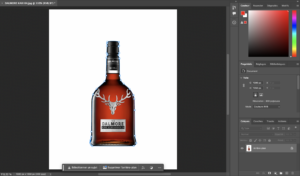Product Photo Retouching
In this article :
In the world of visual marketing, a product’s image is much more than just a representation: it is a strategic tool to attract and persuade the consumer. Product photo retouching thus plays a central role by enhancing details, correcting imperfections, and optimizing the visual presentation of a product. This article offers an in-depth look at what product photo retouching involves, its specific techniques, and its benefits in strengthening brand image.
What is product photo retouching?
Product photo retouching refers to the set of techniques applied to enhance the image of a commercial object. The goal is to present the product in its best light by improving its visual quality and removing any elements that could distract the viewer.
Concrete example: A watch packshot may require precise outlining of the object, color balancing, and removal of unwanted reflections to achieve a flawless result.
Product photo retouching stands out for its meticulous and targeted approach, which differs from other types of retouching, such as landscape or portrait retouching. It focuses on:
- Precision in outlining: to isolate the product from its background.
- Color adjustment: to faithfully reproduce the original hues or enhance them.
- Imperfection correction: to remove dust, scratches, or lighting flaws.
Each image undergoes a transformation process aimed at making the product irresistible to the consumer.
The Goals of Product Photo Retouching
Enhance the Product:
One of the main goals is to highlight the product’s strengths. Well-executed retouching helps to:
- Improve texture and details, making every component visible and appealing.
- Optimize lighting to give the object depth and dimension.
- Harmonize colors to create a cohesive image that stays true to the brand’s identity.
Strengthen the Brand Image:
A high-quality image boosts credibility and reinforces the brand’s image. In e-commerce and advertising, product photo retouching directly contributes to:
- Capturing consumer attention on online platforms.
- Creating a consistent visual world that sets the brand apart from its competitors.
- Enhancing the product’s features to tell a compelling story.
These goals result in visuals that not only captivate but also build trust and stimulate purchase desire.
Techniques and Methods Used
Product photo retouching relies on a set of precise techniques, each tailored to highlight the specific characteristics of the product. Here are some commonly used methods:
Cutting Out and Isolation
Cutting out is often the first step. It involves isolating the product from its background to eliminate any distractions. This technique requires great precision to ensure the product remains sharp and well-defined, especially in the case of items with complex edges.

Color and Exposure Adjustment
A meticulous adjustment of colors helps correct lighting variations and ensures that the product’s hues are accurately reproduced. Exposure adjustments, often combined with the use of tone curves, enhance contrast and add dynamism to the image.

Removal of Imperfections
Retouching tools allow for the removal of imperfections such as spots or unwanted reflections that could distract the consumer. This step is crucial for achieving a clean, professional final result. In Photoshop, tools like the Healing Brush or the Clone Stamp are often used for this purpose.
Adding Subtle Effects
Sometimes, a slight artistic blur or a touch of vignetting can help highlight the product. These creative adjustments contribute to creating a specific atmosphere that enhances the visual impact of the image.
Impact on Marketing Communication
Retouched product images play a crucial role in marketing communication. In a market where the image is the first point of contact with the consumer, product photo retouching contributes to:
- Optimizing the presentation of products on e-commerce websites and catalogs.
- Strengthening the brand’s visual identity through cohesive and aesthetically pleasing visuals.
- Stimulating engagement by capturing attention and evoking emotion.
A carefully retouched image can transform a simple product page into an attractive display, capable of sparking the desire to purchase and encouraging the consumer to learn more.
Conclusion
Product photo retouching is an essential discipline for any professional looking to enhance the appeal of sales objects and strengthen brand identity. By mastering techniques such as masking, color adjustment, and imperfection removal, the retoucher transforms each image into a powerful visual communication tool.
This approach allows the creation of striking visuals that capture attention and spark consumer interest. For those looking to deepen their expertise in this field, it is crucial to explore and refine these techniques in order to meet the demands of an ever-evolving market.
Jérémy Carlo is the editorial director at Rétines, where he ensures the consistency and clarity of all content produced by the studio.
Our Clients
Let’s discuss
What we do for you at Rétines
Meticulous work, an organised project and fast delivery. And to achieve this, we mobilise the right resources in our teams at the right time.
01
Pre-production
Artistic and technical direction tailored to the project.
Relevant recommendations on content, form and resources.
02
Photo Shooting
Photos taken by our experienced photographers.
Production that’s controlled, efficient and tailored to the needs of the project, with nothing superfluous.
03
Retouching
Technique
Photographs magnified by our retouching team.
Post-production to meet the commercial challenges of the brief.












